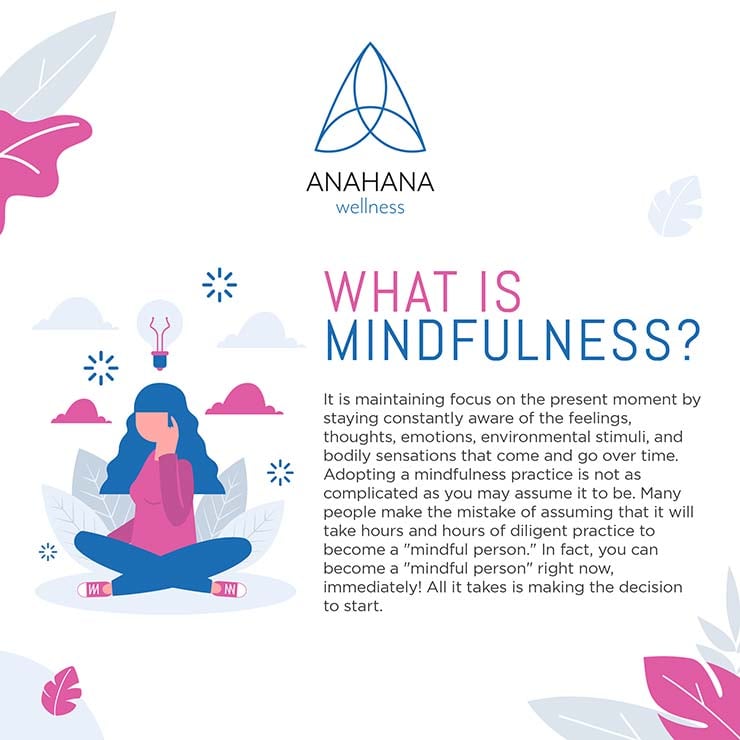
Table of Contents
No matter where you are in your life right now, mindfulness can transform your existence for the better. Frequently, individuals look to mindfulness under challenging times.
Daily Mindfulness
No matter where you are in your life right now, mindfulness can transform your existence for the better. Frequently, individuals look to mindfulness meditation in difficult times — during a divorce or breakup, after losing a loved one, being diagnosed with a critical illness, or simply in the middle of an extra stressful period in their lives.
When we look to mindfulness for help, we’re searching for a way around the madness of life. Many of us are seeking escape to avoid pain, confusion, and heartache. Fortunately, mindfulness can help heal all of these types of suffering.
Counterintuitively, this meditation practice offers us a way through life’s difficulties instead of a way around them. Rather than avoiding difficult situations, mindfulness forces us to confront our fears and anxieties gently, reassuringly. Being mindful, focusing on the present moment, and not fearing the thoughts and emotions we experience is the medicine we desperately need today. Yet it is also the one we try so hard to avoid.
The guide below will outline everything you need to know about mindfulness meditation practice and how to start fulfilling mindfulness of your own. Rest assured that this practice is one of the endless benefits. Once you begin, we can say with the utmost confidence that you’ll wonder why you ever waited so long to start.
What Is Mindfulness?
There's no doubt you've already heard of mindfulness. It's in books, magazines, blog posts, YouTube videos, and just about everywhere else. Still, many people don't know what mindfulness training really is.
Often, people have some vague idea that mindfulness exercises have something to do with meditation, Buddhism, and staying present. And indeed, this is true! These are all excellent places to start! But the truth is mindfulness is quite a fundamental concept at its root. It's something you can do anytime, anywhere.
To give a broad explanation of the term, we can define mindfulness as:
Maintaining focus on the present moment by constantly staying aware of the feelings, thoughts, emotions, environmental stimuli and paying attention to bodily sensations that come and go over time.
Adopting a mindfulness practice is not as complicated as you may assume. Many people mistakenly think that it will take hours and hours of diligent practice to become mindful. You can become that person right now — immediately! All it takes is deciding to start learning mindfulness skills.
Mindlessness Vs. Mindfulness
The word mindless is often thrown around to mean acting in an aloof way or without thought. It's usually used in isolated situations in which someone does something absent-minded. But Harvard social psychology professor Ellen Langer1says that many people are actually mindless most of the time. Langer herself does not exonerate herself from being mindless as well. “I once bumped into a mannequin, and I apologized,” she stated in an interview with The Harvard Gazette.
In the same interview, Langer went on to say this about mindlessness:
“The consequences of being mindless are enormous, and I have 40 years of research to supply evidence that most of us are ‘not there’ much of the time. When you’re mindless, you’re not able to take advantage of opportunities that present themselves, you’re not able to avert danger not yet arisen, you’re not there, and you’re oblivious to not being there.”
So, do you feel mindless in day-to-day life?
Many people would say no, but if you consider that mindlessness is a state of not focusing on the present moment and instead on either the past or the future, it's easy to see that many people are mindless for large portions of their day, as Langer suggests.
Just consider how often you’re thinking about the past or the future yourself. When you are in a boring business meeting, do you find yourself wondering what you're going to do after the meeting is over? Are you daydreaming about the delicious lunch you'll have that afternoon or deciding what you'll wear on a night out?
Or, let's say you’re supposed to be studying for a big exam. But instead, you are thinking of that party you went to last week or wondering how you did on an exam you just took?
To be sure, for moments throughout the day, we are able to focus on the task at hand, but these moments are often fleeting. It's probably not uncommon for you to realize that your mind wanders more than it stays put. This isn't bad, per se. But it can have negative effects over time, and it's often more of a problem when we don't notice that our mind is wandering.
Cultivating mindfulness as a regular daily practice means to combat the wandering mind.
Why Practice Mindfulness?
 Mindfulness practices regularly, even just for a short time, bring various excellent benefits. On the surface, it can help you heighten your focus, improve your memory and recall of information, and make you a better listener. If you are in school or have a highly challenging job, these skills will be beneficial.
Mindfulness practices regularly, even just for a short time, bring various excellent benefits. On the surface, it can help you heighten your focus, improve your memory and recall of information, and make you a better listener. If you are in school or have a highly challenging job, these skills will be beneficial.
In addition, mindfulness benefits the body physically. Mindfulness has been linked to pain reduction, especially for chronic conditions such as lower back pain, fibromyalgia, and other musculoskeletal pain.
It also improves mental and emotional health by reducing stress and anxiety. This, in turn, can reduce the occurrence of mental health conditions such as depression. Mindfulness has also been linked with better sleep. Finally, studies have shown that mindfulness can improve and strengthen the immune system. We'll talk more about the benefits of mindfulness later on.
The Origins of Mindfulness
Anyone can practice and benefit from mindfulness — no matter your religion, denomination, or whether you’re an atheist, agnostic, or practitioner of another spiritual doctrine. Mindfulness is simply a way of being.
Still, if you want to understand how mindfulness came to the Western world, we can go back more than 2,600 years to when the Buddha became enlightened himself and first taught the wisdom of being mindful.
The Buddha And The Four Foundations of Mindfulness
The Buddha — Siddhartha Gautama — called mindfulness “the path to enlightenment.” To spread the word of enlightenment, he asked that his senior monks (called bhikkhus) teach a doctrine called The Four Foundations of Mindfulness. When the bhikkhus asked the Buddha which four foundations they were to teach, the Buddha responded:
Dwell contemplating the body in the body, ardent, clearly comprehending, unified, with concentrated one-pointed mind, in order to know the body as it really is.
Dwell contemplating feeling in feelings … in order to know feelings as they really are.
Dwell contemplating mind in mind … in order to know mind as it really is.
Dwell contemplating dhamma* in dhammas … in order to know dhammas as they really are.
*By dhamma, the Buddha is referring to phenomena, or the total of one’s experience, including all mental events that arise within us from moment to moment.
Each of the Four Foundations of Mindfulness is generally seen as a stage of learning to be completely mindful in each moment. That is, the first stage is to focus on being aware of the body. This is often done by simply focusing one’s attention on the breath. From there, the rest of the body is considered, including all sensations.
Next, feelings are examined in-depth with mindfulness practice. This includes emotions and any bodily sensations that accompany those feelings or emotions. After that, the mind and thoughts are closely examined. And finally, the totality of one's experience and all mental events are closely focused on.
Noticing Without Judgement
One of the keys to embracing mindfulness is noticing without judgment. As you progress through the Four Foundations of Mindfulness, you must see each foundation without judging them.
This is harder than you may think. For example, while trying to be mindful and focus on your deep breath, your mind might wander, and you may start to think of a fight you recently had with your significant other. Because of this, you may begin to feel anger, sadness, and frustration. But the goal of being mindful of the thoughts arising — even while trying to focus on the breath — is to notice those thoughts and not judge them.
If you're thinking about a fight you had with your significant other, you will judge those thoughts and try to push them away. But the goal is not to push away thoughts, feelings, emotions, or other sensations. Instead, it is to notice them, not judge them, and return your focus to your original intention.
Jon Kabat-Zinn and the Arrival of Mindfulness in Western Culture
Mindfulness as a practice has its origins in Buddhism, so how did it travel from Eastern philosophy to the yoga studios, schools, and hospitals of North America, Europe, and elsewhere? Most people credit a man named Jon Kabat-Zinn.
Of course, many others helped transition mindfulness to the Western World, but Kabat Zinn was a visionary in the world of mindfulness before most Americans had ever heard of the term.
In 1971, Kabat-Zinn began studying meditation. In the late ‘70s, he undertook his postdoctoral work at the University of Massachusetts Medical School. In 1979, he finally decided to take his training and practice in meditation to the next level by bringing all he knew to Americans who struggled with chronic anxiety, stress, depression, and other mental health conditions. He did so by establishing the Mindfulness-Based Stress Reduction Clinic at the Medical School of the University of Massachusetts — the first of its kind.
By bridging the gap between the Eastern philosophy of mindfulness and the desperate need for more mindful living in the Western world, Kabat Zinn became a pioneer in helping Americans and other Westerners fight the 21st-century plague of chronic stress. His introduction of these philosophies opened many other gateways from East to West — through books, Eastern speakers, meditation centers, retreats, and more.
Mindfulness practice means that we commit fully to each moment to be present, inviting ourselves to interface with this moment in full awareness, to embody as best we can an orientation of calmness, mindfulness, and equanimity right here and right now.
― Jon Kabat-Zinn
Kabat-Zinn’s Mindfulness-Based Stress Reduction Clinic at the Medical School at the University of Massachusetts continues strong.
The Benefits Of Mindfulness

Most people who begin practicing mindfulness are apprehensive. After all, mindfulness claims many benefits, but how can simply focusing on the present be so pervasively helpful?
Time and again, science backs the idea that mindfulness will make you healthier, stronger, wiser, calmer, and better at basically … everything you want to accomplish.
Here’s how mindfulness can help you:
Improved Mental Health
According to researchers at Harvard5, 16.1 million Americans reported struggling with depression in 2015. Yet while there are numerous interventions available, including medication and cognitive behavioral therapy, not all patients respond well to these solutions.
On the other hand, mindfulness has improved mental health, and a growing body of research supports this.
A meta-analysis of systematic reviews found that “Compared to waitlist control and compared to treatment, as usual, MBSR [mindfulness-based stress reduction] and MBCT [mindfulness-based cognitive therapy] significantly improved depressive symptoms.”
Improved Physical Health
A recent 2018 study showed that undertaking a mindfulness practice for just 15 minutes a day helped lower blood pressure in participants. Those who regularly partook in mindfulness meditation for over eight weeks showed improved glucose metabolism, reduced inflammation, and circadian rhythm regulation. An excellent way to introduce this into one´s life is by doing walking meditation or walking meetings at work. This benefits the practitioner both physically and mentally.
Reduced Stress and Anxiety
Jon Kabat-Zinn is especially well-known for linking mindfulness to reducing stress and anxiety as the head of the Center for Mindfulness in Medicine, Health Care, and Society at the University of Massachusetts Medical School. Through the center, people from all walks of life, with a wide array of challenges, undergo mindfulness programs to help them "approach life with more composure, energy, understanding, and enthusiasm."
Additionally, in a 2013 Massachusetts General Hospital study, it was determined that after undergoing an eight-week mindfulness-based stress reduction program, participants had significantly reduced their anxiety, compared to the control group who did not undergo the same mindfulness program but instead underwent generalized stress management education.
Improved Focus
Overall, mindfulness practice also increases gray matter in the mid-mind, linked to higher IQ scores, improved focus and concentration, and superior communication skills.
Additional Benefits
These are but some of the mental health benefits. Other benefits include:
-
Reducing negative thoughts.
-
Physical pain, even chronic pain.
-
Easier to fall asleep at night
-
Gain control, regulating emotions and emotional state.
-
Improved physical sensations.
-
Overall improved well-being.
Mindfulness work is a simple practice that anyone can pick up with the help of a mindfulness instructor. It is never too late to start especially given what mindfulness helps with.
Mindful body scan
During guided sleep meditations, the instructor will perform what's referred to as body scanning or body scan. But what is a body scan?
Body scan meditation is another word for meditation done in a mindful state, promoting body awareness. With the help of visualization and physical sensation, the practitioner increases their attention, connecting the mind with the body, keeping both in the present moment. It is often used in guided meditation sessions and yoga, particularly Yoga Nidra.
Not all instructors will be performing a body scan, at least not initially. Once the practitioner is more comfortable with mindful meditation, the instructor might introduce this to help with self-regulation tension release, with the help of breathing exercises and meditation programs.
Integrating Mindfulness Into Daily Life: It’s Easier Than You Think!
If you are interested in integrating mindfulness into your everyday life and becoming more mindful in every aspect of your life, the good news is that it's easier than you think!
You can teach yourself to be mindful every day if you like. Mindfulness is the practice in Buddhist teaching — essentially, everything is mindfulness. The simple goal is to focus on the task at hand with mindful awareness. No matter the task, you stay fully aware and focused. Your attention is entirely on whatever you are doing — folding laundry, cooking, playing with your children, working on a report for school, or just taking a walk.
Items you can introduce into your daily life to improve mindfulness include:
-
Calm or soothing music: Listening to some calming or soft music whenever possible. Music has an emotional effect on many of us and can help bring us to a more calm and relaxed state.
-
Mindful Schools: Allow your child/children to attend an aware school that focuses on children's wellbeing.
-
Mindful activities for kids: Try to get your children involved in mindful activities for kids, such as mindful coloring or nature walks. This is not just for the little ones; there is also mindfulness for teens facing the stress of school and peer pressure.
-
Mindful parenting: Mindful parenting goes hand in hand with mindful activities for children, but in addition to what's mentioned above, you could also teach them STOP: Stop, Take a breath, Observe, and Proceed.
-
Mindfulness-based decisions: When you are faced with something, make sure it's a mindfulness-based decision that you make and not something made out of haste and without thought.
-
Mindful health: Practice mindful health by eating correctly, exercising regularly, listening to calm music, watching soothing videos, or practicing conscious breathing.
-
Calming videos: Watching calming videos could be an excellent tool to wind down and relax.
-
Mindful movements: When you are out and about or at home, you practice mindful movements. Take it slow and easy.
-
Mindful walking: A walk in nature, alone or with your loved one or your children, is an excellent way to participate in walking meditation. Enjoy every minute, pay attention, turn off your phone and be fully present. Forest Bathing is one of the names of this practice, and it helps with significant reductions in stress and anxiety.
-
Mindful eating: Take extra care in what you put in your mouth and how you do it. Mindful eating will help in many ways.
-
Mindful exercise and training: A mindful movement or training is something you should practice a couple of times a week if possible.
-
Mindful meditation: Learn how to unwind with some mindful meditation. If you don't know-how, allow us to help you.
-
Start paying more attention to your surroundings: Don't be the one that rushes through life, watching your phone 24/7. Start paying more attention to your surroundings and, above all, enjoy them whenever possible. The benefits of making mindfulness part of daily life are endless.
The Basics Principles Of Practicing Mindfulness

Below, we outline the basic tenets of mindfulness to get you started.
Focus On The Breath
You don't always have to focus on the breath to be mindful, but it's an excellent place to start — especially if you want to stay in line with the Four Foundations of Mindfulness. In this case, focusing on the breath would fall under the first foundation: mindfulness of the body.
Your body is always breathing. It is the most crucial function of your body that you don't even have to think about. Still, you can control your breath — how fast or slow it is, how deep or shallow it is, and at what pace you breathe.
To focus on the breath, think about the air going slowly into your mouth or nostrils, filling up your lungs, then gently flowing out again as you exhale. Count to four on the in-breath. Count to four again as you hold the air in your lungs, and finally count to four as you exhale, a practice called box breathing.
Notice Thoughts And Emotions Without Judgement
See your thoughts and emotions come and go without judging them. Remember that the goal of mindfulness is not to avoid thinking or feeling anything. You are not trying to cultivate an empty mind or complete clarity here. Your mind will wander, and you should expect that. Simply notice when it does, and tell yourself that it's happening.
For example, if you ruminate about yesterday’s meeting with a client, you might say silently to yourself, “thinking about meeting” or “worrying about the meeting.” Or, if you suddenly become sad when you remember a fond memory, you might silently say, “feeling sad about X memory.” If you feel excited about a date you have in the evening, tell yourself, “feeling excited about tonight’s date.” After each nonjudgmental statement, return your focus to the breath, the surrounding environment, and the current moment.
Notice Bodily Sensations Without Judgement
Notice how your body feels at the current moment. When is your body touching the ground or the chair you're sitting in? Be aware of the sensation of the material you are sitting or standing on. How do your toes feel in your socks? How do your shoulders feel? Can you notice a rumble in your stomach? Feel the expansion of your abdomen as your lungs inhale. Notice each of these sensations without judgment.
Notice Sights, Sounds, And Smells Without Judgement
Do you have a specific taste in your mouth or a scent in your nose? Where is the smell coming from? What do you hear? Is it the sound of a truck passing by? The wind wafting through tree branches? Are you talking to someone? Listen to what they are saying, but also think about the timbre of their voice. Look at their face, notice their skin, the softness of their hair, and how their lips move when they speak. Notice each of these sensations without judgment.
Learn To “Surf” Your Urges
Lastly, if you feel any urges, learn to surf them. This means learning to ride out immediate desires such as needing to scratch an itch on your nose or getting up to get a drink of water. These aren't wrong actions, but when you want to hone your ability to focus on one thing at a time, you must learn to disregard urges like these — not forever, of course. We say you need to know how to surf your desires or ride them out until you're finished with your moment-to-moment practice.
A Simple Mindfulness Practice For The Beginner
We’ll use a specific situation as an example of when and how you can practice mindfulness. In this case, let’s say you are about to fold a load of towels that’s just come out of the dryer. Here’s how you could take this opportunity to practice mindfulness.
1. Do only one thing at a time.
Start by deciding to fold the laundry and only fold the laundry. Don’t put the TV or music on while you do this task. Don’t talk to anyone else while you fold. Simply focus all of your attention on folding this one load of laundry to the best of your ability.
2. Be deliberate and slow with your actions.
Don't rush to get everything folded quickly. This activity is all you're doing right now, and it deserves your full attention. Take care with each motion and action. Line up the corners on the towels nicely. Organize your folding into neat stacks of like kinds of towels. Pick off lint and put it into a pile.
3. Enjoy the experience.
Take pleasure in what you're doing. Are the towels warm and cozy from recently being in the dryer? Feel the warm fibers on your fingertips. Hold them against your cheek. Smell the fresh scent of your laundry detergent. Enjoy stacking all of the towels in a neat and organized pile, ready for your linen closet.
4. When your mind wanders (and it will), simply notice it without judgment and return it to the task.
You will inevitably begin to think about what you're going to do later that evening, how you should probably buy new towels because they are getting old, or what you'd rather be doing other than folding towels. That's okay! The goal here is, once again, to simply notice your mind wandering, tell yourself where your mind is wandering to (silently think to yourself, "I'm thinking about what to have for dinner tonight," for example), and bring your focus back to the current moment and what you're doing: folding laundry.
3 More Ways to Be More Mindful in Your Daily Life
1. Learn to watch your mind wander.
Most people see their mind wandering as a bad thing. Daydreamers are considered foolish and unsuccessful. But the truth is that minds do wander, and it's okay to let them. The key is to rein in your thoughts and teach your mind to notice when it wanders before returning to the present moment. It's a freeing experience.
2. Learn to be boring.
People often mistake that their lives need to be eternally and consistently exciting. This feeling is exacerbated by social media, in which we see all of our friends, family members, celebrities, and random other people enjoying exciting activities seemingly every day. FOMO or the fear of missing out is a phrase that refers to the sensation that if you're not hang gliding, windsurfing, jetting off to Europe, or getting married, you're not living life.
This couldn't be further from the truth. By learning to be boring, you are not accepting a boring lifestyle. You are not telling yourself not to enjoy a fulfilling life. Instead, you see excitement and thrill in the brilliant everyday moments of life. This is a beautiful way to exist.
3. Slow down.
This is a great reminder to write on Post-it notes and keep at your desk, on your refrigerator, or in your bathroom mirror. The two simple words, slow down, help us remember taking life one moment at a time. Everyone's life is a journey. You cannot win life. Simply take it moment by moment and learn to enjoy the ride.
Make mindfulness a daily practice and reap the rewards that come with it.
Mindfulness: Frequently Asked Questions
What is the difference between mindfulness and meditation?
Generally speaking, mindfulness is a state of being, and meditation is deliberate practice — almost like an activity. You can use mindfulness while doing absolutely any activity, such as forest bathing. You cannot meditate any time, however. Meditation is more like sleeping. It is an activity that is meant to somewhat alter your state of mind. While mindfulness does this as well, it does not do so drastically. Instead, it is like putting a mindful filter on whatever you are doing at any given moment.
How can I be mindful all day?
While it is certainly more accessible than you think to become mindful every day regularly, it is also unnecessary to attempt to be conscious 24/7/365 right away. Mindfulness practice can certainly be achieved at a maximum level, in which you are mindful throughout every activity that you do throughout the day. But if you want to go slowly and simply start by being mindful while you wash the dishes or mindful while you exercise, that is a great place to begin. Slowly, build your focus, attention, and capacity for mindfulness, and you will start to see amazing results in time.
How can I stay mindful when I am super busy?
When your life is significantly hectic, the best way to stay mindful is to carry out one activity at a time. One of the pitfalls that many people encounter when super busy is that they try to do too many things at once. If you feel that your life is hectic and crazy, reflect on whether you are trying to do multiple activities at one time. For example, are you responding to emails during your lunch hour? Taking conference calls on your drive home from work? Watching TV while you talk with your family in the evening? Sometimes life gets hectic, and it is unavoidable. If you want to stay mindful during these difficult times, the first thing to do is tell yourself: one thing at a time. By focusing on a single task at a time, you embody the spirit of mindfulness.
How can I be mindful at work?
There are several ways to cultivate mindfulness at work. First, try not to multitask. Focus on one thing at a time. Second, when it's time to rest, rest. In other words, when it's your lunch hour, don't continue working. Instead, treat your lunch hour as what it is: a time to eat. Focus on your food, how it tastes, and all of the textures and smells you experience. When working with others, listen. Focus on the person who is speaking and give them your full attention before responding. Lastly, take breaks from technology. Although helpful in many ways, devices like smartphones and tablets are not conducive to consistent mindfulness because they scatter our focus and keep us from truly living and experiencing the world around us.
How can I teach my children mindfulness?
The best way to teach your child any vital life skill is to lead by example. When your children see you focusing on one task at a time, giving your full attention to whatever you are doing, and staying in the present moment, they will learn to do the same. You should also try and incorporate mindful activities for kids in their spare time. Speak with their teachers about bringing mindfulness in the classroom.
Also, you should try to practice more mindful parenting whenever possible or teach your child breathing techniques for kids.
Learning To Stay In The Present Moment Will Be A Lifelong Intention

Are you ready to try the practice of mindfulness for yourself? It’s easier to begin than you think.
Remember that everyone can change, learn, and grow — no matter what your goals are. Whether you start tomorrow, next week, or right now, the only thing potentially holding you back is yourself and the limitations you create.
Also, remember that if you start a mindfulness practice and don’t feel anything right away, that’s normal. Mindfulness practice is not like taking a pill. It’s not black and white, and you won't suddenly become a brand-new person when you start to live more in the present. Instead, you must be patient, trust the process, and keep returning to the practice. Over time, you’ll begin to see small changes at first, then bigger and bigger ones in your life as a whole. The good news is that these changes will only be positive. There are no downsides to mindfulness practice.
In addition, there’s no achieving mindfulness. It’s not something like graduating from college or buying a house. You can’t finish or win mindfulness. However, you can give away mindful gifts to those you feel need some mindfulness in their life.
Instead, mindfulness is a journey you’ll be on for the rest of your life. And that’s a good thing because it’s a journey with endless benefits. By constantly nurturing the practice of mindfulness, you’ll be nurturing your soul’s freedom, providing space for your mind and heart to breathe, and embracing the fact that life is ever-changing and ever-evolving. And that’s the way it’s supposed to be.
Wherever you go, there you are
― Jon Kabat-Zinn
Resources
Ellen Langer — Science of Mindlessness and Mindfulness | The On Being Project
Mindfulness for Physical Pain | Taking Charge of Your Health & Wellbeing
Alterations in brain and immune function produced by mindfulness meditation
The Four Foundations of Mindfulness - Lion's Roar


By: Clint Johnson
Clint is the driving force and founder of Anahana. Clint teaches Yoga, Pilates, mindful breathing, and meditation, catering to a global community of students and teachers.
